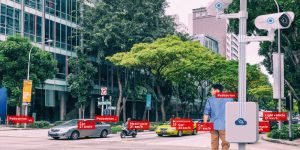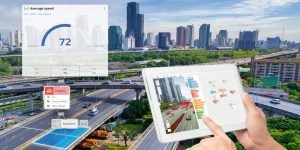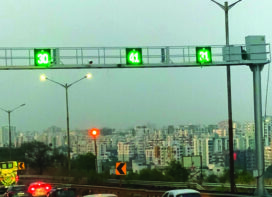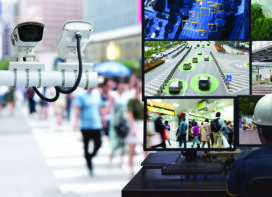
Nagendra Reddy V, CEO & Founder, VTRAC Worldwide
Usage of inventive Traffic Video Analytics systems in countries like India can play a bigger game in analysing and optimizing the road traffic resulting in reduced congestion and controlled traffic movement in all types of roads writes Nagendra Reddy V, CEO & Founder, VTRAC Worldwide
Currently India possesses close to 700 toll plazas on a stretch of around 30,000 kms and plans to implement more on express highways of about 7,800 kms in a five year plan to meet the requirement of increased vehicles day by day. In conjunction with the increased population, transit infrastructure demand is also increasing, but resources remain scarce. At this scenario, it is highly recommended for the plazas to adopt new technologies that will help in toll operations as per public need. The Governments face increasingly challenging situations between managing maintenance backlogs and addressing the growing population’s needs.
Essentially, this means that resources should be spent on optimizing existing assets rather than creating new ones. Enhancement in operating efficiency does not only limit cost savings, but also lead to increased customer satisfaction, longer asset life, and improved usage. The use of video data and analytics for toll collection and operations is one such focus area. To increase the efficiency of their operations, most public and private asset owners are searching for new ways to cut costs. As a result, with the advent of innovative tolling systems such as Open Road Tolling (ORT), Electronic Toll Collection (ETC), and Global Positioning System (GPS), the industry has been revolutionized and operations have become highly efficient. The new and innovative technological interventions are primarily intended to extend service and reduce travel time.

Several measures have been taken by the government of India in order to reduce road fatalities, such as amending the motor vehicle act, implementing the Good Smart law, launching awareness campaigns, and allocating hefty funds for blackspot identification and rectification. In support of such measures, video analytics can be a valuable tool. Several studies indicate that the faster emergency responders can reach for help, the lower the fatality risk. The use of advanced video analytics software on live CCTV feeds can help ensure a timely response. Such a system possesses the capabilities for detecting traffic violations or accidents in real-time by analysing video streams in real-time. Additionally, a traffic control centre can receive an alert immediately so that assistance can be dispatched to provide immediate assistance. One example of this kind of system can be found in Israel, where Ashdod city authorities have implemented a smart traffic monitoring system to increase road safety. Along with enhancing road safety, this solution also helps in improving traffic flowing and preventing congestion. Along with Israel, other countries such as the United States, Singapore, the UK, Ireland, and Iraq have also crash detection systems in place. The British startup Axitech develops systems for automated collision detection and management. In addition to breakdown (bCall) and emergency (eCall) calls, the startup utilizes cloud-based collision detection algorithms. Additionally, US-based Company GeoZilla provides its customers with emergency contact alerts from its smartphone app for detecting crashes.

The app uses the motion sensors on a smartphone to identify accidents and sends an alert message that includes GPS data of the collision. Singapore-based Tangerine develops fleet management solutions that detect crashes. The company provides an array of proprietary Jido products for tracking and sensing vehicles. In addition to measuring vehicle location, speed, and distance, Jiro Sense also captures data on braking, acceleration, and cornering thanks to an accelerometer, magnetometer, and gyroscope.
By combining its data with AI-powered dashcam video analytics, the start-up offers fleet managers a comprehensive accident detection tool.
In Indian cities, video analytics-based interventions are very much needed to improve the data collection, data quality and data analysis for implementing better solutions. With the advancement of technology, a lot of private players and organizations have started to provide traffic solution based services using data analytics. The aim is to provide services for traffic monitoring and management, road safety for NMT users, traffic violation and lane discipline services. Using real-time traffic data, VTRAC Worldwide and its technological partner DataFromSky (DFS) offers a complete Traffic Video Analytics and Automation System under various technological aspects.

The platform is a powerful new foundation and all-in solution for traffic controlling and monitoring. With situational awareness and actionable intelligence, it is capable of deeply analysing all types of movements from a camera network of any size. The system is enabled to automatically detect all objects including pedestrians and cyclists, categorize them into multiple categories, automatically detect congestions & incidents, analyse every motion in detail and to do predictive analytics. Along with data collection, the real-time traffic data system can read speed and passage of time, colours license plates on a large scale, the road user’s path, journey time and more.
The system can interpret movements with the support of telematics integrated with the system, evaluate level of service, generate OD matrices, calculate heat maps, identify blind spots and provide fully user-customizable traffic insights on the fly. It is one of the perfect tools for monitoring traffic scenes at highways or two-lane roads or on any other roads. The system is a non-intrusive and all-in-camera solution capable of providing advanced traffic statistics such as category counts for given periods, gap times, level of service and much more. In addition, it can track each vehicle’s trajectory in detail – measure time of occurrence of all traffic events; detect car stops, wrong-way driving and vehicles parked at restricted / illegal areas. The system can read the speed patterns followed by the drivers on specific areas, like blind spots or hairpin bends where the chances of accidents happening is frequent, so that the necessary measures can be taken to avoid such.
 TrafficInfraTech Magazine Linking People Places & Progress
TrafficInfraTech Magazine Linking People Places & Progress


